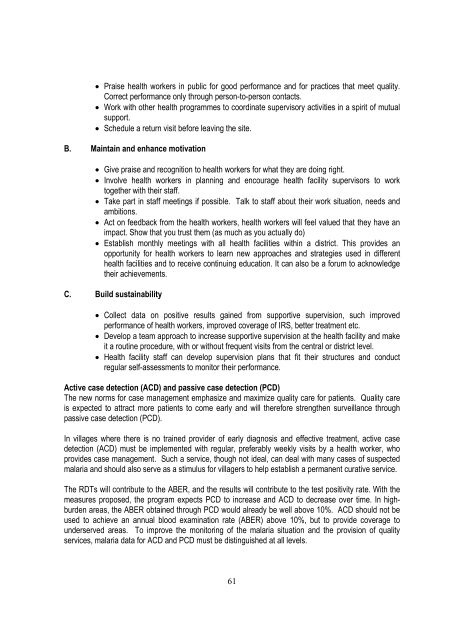training module for medical officers primary health centre - NVBDCP
training module for medical officers primary health centre - NVBDCP
training module for medical officers primary health centre - NVBDCP
- No tags were found...
You also want an ePaper? Increase the reach of your titles
YUMPU automatically turns print PDFs into web optimized ePapers that Google loves.
Praise <strong>health</strong> workers in public <strong>for</strong> good per<strong>for</strong>mance and <strong>for</strong> practices that meet quality.Correct per<strong>for</strong>mance only through person-to-person contacts. Work with other <strong>health</strong> programmes to coordinate supervisory activities in a spirit of mutualsupport. Schedule a return visit be<strong>for</strong>e leaving the site.B. Maintain and enhance motivation Give praise and recognition to <strong>health</strong> workers <strong>for</strong> what they are doing right. Involve <strong>health</strong> workers in planning and encourage <strong>health</strong> facility supervisors to worktogether with their staff. Take part in staff meetings if possible. Talk to staff about their work situation, needs andambitions. Act on feedback from the <strong>health</strong> workers, <strong>health</strong> workers will feel valued that they have animpact. Show that you trust them (as much as you actually do) Establish monthly meetings with all <strong>health</strong> facilities within a district. This provides anopportunity <strong>for</strong> <strong>health</strong> workers to learn new approaches and strategies used in different<strong>health</strong> facilities and to receive continuing education. It can also be a <strong>for</strong>um to acknowledgetheir achievements.C. Build sustainability Collect data on positive results gained from supportive supervision, such improvedper<strong>for</strong>mance of <strong>health</strong> workers, improved coverage of IRS, better treatment etc. Develop a team approach to increase supportive supervision at the <strong>health</strong> facility and makeit a routine procedure, with or without frequent visits from the central or district level. Health facility staff can develop supervision plans that fit their structures and conductregular self-assessments to monitor their per<strong>for</strong>mance.Active case detection (ACD) and passive case detection (PCD)The new norms <strong>for</strong> case management emphasize and maximize quality care <strong>for</strong> patients. Quality careis expected to attract more patients to come early and will there<strong>for</strong>e strengthen surveillance throughpassive case detection (PCD).In villages where there is no trained provider of early diagnosis and effective treatment, active casedetection (ACD) must be implemented with regular, preferably weekly visits by a <strong>health</strong> worker, whoprovides case management. Such a service, though not ideal, can deal with many cases of suspectedmalaria and should also serve as a stimulus <strong>for</strong> villagers to help establish a permanent curative service.The RDTs will contribute to the ABER, and the results will contribute to the test positivity rate. With themeasures proposed, the program expects PCD to increase and ACD to decrease over time. In highburdenareas, the ABER obtained through PCD would already be well above 10%. ACD should not beused to achieve an annual blood examination rate (ABER) above 10%, but to provide coverage tounderserved areas. To improve the monitoring of the malaria situation and the provision of qualityservices, malaria data <strong>for</strong> ACD and PCD must be distinguished at all levels.61
















